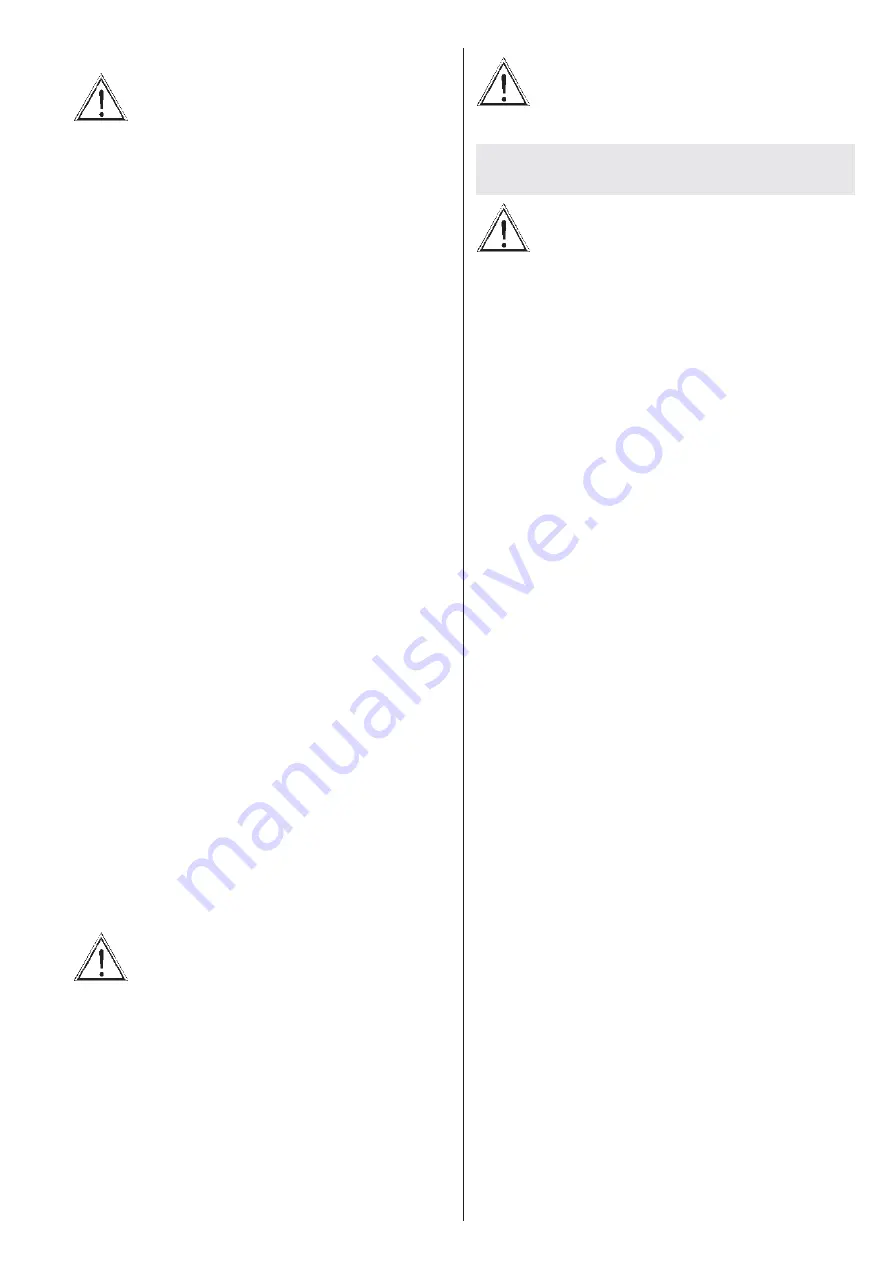
16
COMMAND AND CONTROL DEVICES.
Before connecting the machine to the
water supply and to the power mains, it
is essential to know the function of the cleaner's
command and control devices.
IMPORTANT.
The cleaner must operate with clean water.
Dirty or sandy water, corrosive chemicals
and solvents can cause severe damage to
the cleaner.
Failure to respect the above absolves the manu-
facturer of all liability and represents negligent
use of the product.
ELECTRICAL CONNECTION
Connection of the cleaner to the mains must be
carried out by skilled technicians able to ensure
that all regulations in force are complied with use
in respect of current standards and legislation.
Ensure that the mains voltage available is the same
as the voltage at which the cleaner is supposed to
work; this is indicated on the identification plate.
The electric cable must be protected from acci-
dental crushing.
Do not use the machine if the supply cable is
damaged.
The use of any electric appliance requires
the respect of some basic rules:
- Do not touch the appliance with wet or damp
hands or feet.
- Do not use the appliance bare-footed or with
unsuitable clothing.
- Do not pull the supply cable or the appliance
itself in order to disconnect the plug from
the electric supply. (For water cleaners rated
at less than 3 kW fitted with plug).
As for the protection against electric shock, the
H.P.cleaner belongs to
CLASS I
.
Failure to observe the above warning
frees the manufacturer from all re-
sponsibility and constitutes negligent
use of the product.
WATER CIRCUIT CONNECTION
Connect the feed hose to the mains (fig. 8A) and
to the hosetail on the cleaner (fig. 8B).
Check that the pressure and quantity of the water
supplied by the mains are sufficient for the cleaner
to work properly: 2 to 8 BAR (29 to 116 PSI).
Maximum temperature of feeding water 50°C
(122°F).
Connect the high pressure hose to the cleaner (fig.
8C) and to the lance (fig. 9).
The H.P. cleaner must not be used by
children, teen-agers or incapable persons
(under the influence of alcohol, etc.)
Use only original accessories that can allow safe
working of the appliance.
The flexible hose connecting the lance to the H.P.
cleaner must not be damaged.
In case of damage, replace it immediately.
Hoses, connections and fittings for high pressure
systems are very important to guarantee the safety
of the H.P. cleaner. Use only original spare parts
which have the manufacturer’s approval.
Do not use the H.P. cleaner when persons or ani-
mals are in its field of action.
High pressure jets may be dangerous if not pro-
perly used.
The jet must never be directed at persons or
animals, electric appliances or at the appliance
itself.
The high pressure water jet causes a reaction
power on the lance. Hold the lance grip vigo-
rously.
The use of the H.P. cleaner must be considered
according to the kind of washing which must be
performed.
Protect yourself against the ejection of solid mate-
rials or corrosive substances by means of adequate
protective clothing. (Gloves, goggles, etc.)
The use of the H.P. cleaner must be considered
according to the place where the washing is per-
formed (for example: food plants, pharmaceutical
plants, etc.)
Pertinent rules and safety conditions must be
followed.
As for the protection against electric shock, the
H.P.cleaner belongs to
CLASS I
.
Do not direct water jets at your own or other peo-
ple’s body in order to clean clothes or shoes.
While working it is forbidden, to stop the trigger
(lever) of the lance in delivery position.
Before starting any cleaning or maintenance ope-
ration, disconnect the machine from the electric
and water supply networks.
Periodically,
at least once a year
, have the safety
devices checked by one of our service centres.
At least once a year, have the safety of the water
cleaner checked by our technical service centre.
Do not use the machine if the supply cable is
damaged.
For the replacement of the damaged cable ap-
ply exclusively to one of our technical service
centres.
G E N E R A L W A R N I N G S A B O U T
INSTALLATION AND USE
Summary of Contents for HDEm 662
Page 1: ...HDEm 662 HDEm 962 D EN CZ LV E P DK N SF GR HU ET LT SLO PL RU...
Page 3: ......
Page 85: ...84 i CE Fig 1 Fig 2 Fig 3 Fig 4 I IEC 60364 1 3 kW kW 1 72...
Page 86: ...85 25 250 bar 360 3600 PSI IEC 60364 1 3 mm 3 kW Total stop O 6 7 12 5...
Page 87: ...86 3 Kw 8 8 2 8 BAR 29 116 PSI 50 C 122 F 8C...
Page 88: ...87 3 Kw 3 Kw 1 8 1 2 10 3 4 5 8 Total stop O 13 A B 1 8 2 3 10 simbolo 4 Total stop...
Page 89: ...88 1 2 3 1 2 3 4 8 1 08 7 5 4 1 2 3 16 C...
Page 90: ...89 1 2 6 3 4 5 6 7 8 18 18 50 500 1 18C 2 18 3 4 19 6 W40 20 1 50 500 50 50 200...
Page 148: ...147...
Page 149: ...148 7RWDO 6WRS o p...
Page 150: ...149 c...
Page 151: ...150 o 7RWDO 6WRS o p o p 7RWDO 6WRS...
Page 152: ...151 PXOWLUHJ...
Page 153: ...152 o p o p 6...
Page 154: ...153...
Page 155: ......
Page 164: ...Notes...
Page 165: ......
Page 166: ......
















































